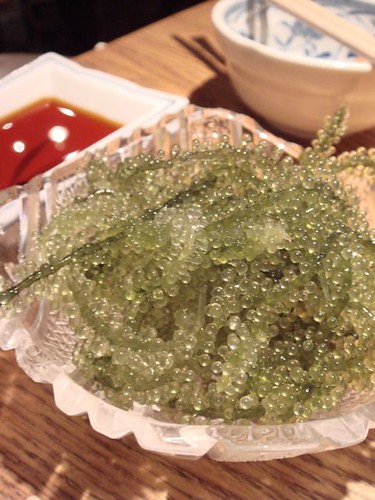
I love lotus root. They're crisp like autumn apples when chopped, and hearty like tororo (grated naga imo, or yam) when grated. Renkon (or lotus root) has a wonderful texture either way, and due to the lack of strong flavor it works well with many different ingredients. I like to chop it up in bite-size pieces and toss it with a rich mentaiko (spicy cod roe) sauce. This is an easy side dish and is great cold, making it an ideal make-ahead-and-let-sit-in-fridge-til-dinner/potluck dish.

Lotus root will start changing color if you let it sit out for too long, ruining the presentation of its almost porcelain-like appearance. So before you start chopping the holey root, let it sit in a mixture of vinegar and water for about 5 to 10 minutes. You should peel the skin with a peeler first.
While it's soaking, prepare the sauce. Scrape the roe from one large or two medium-sized mentaiko sacs. You should make a a long insertion length-wise, spread the two halves so the skin is touching the cutting board, and scrape out the roe with the dull end of a knife, or a spoon. If you are gentle you will not break the membrane. For some reason, I find a squeeze of lemon juice on the mentaiko aids in smooth scraping of the roe.

After you have enough mentaiko (and "enough" depends on how much you like these little eggs!), mix it with the same amount or less of mayonnaise (this, too, depends on how much you like mayonnaise; less mayo and more mentaiko is the way I like it). The mentaiko is salty enough so you won't need any salt for taste.
Let the sauce sit and return to the soaking lotus root. Cut them in bite size pieces, even thin slices. Boil a large pot of water and carefully dump the chopped roots into the boiling water. Let boil for about 3-5 minutes (even less if you've sliced the roots)--that's it! You don't want to lose the delicious crunch of these vegetables by cooking them too long. Taste one after a few minutes and when you feel they need another minute, that's when you should take them out. Because you will...
Use a strainer and allow the roots to cool naturally--do not cool them with water. Right after you have strained them, squeeze half a lemon (or more, if you like lemon! I'm really roundabout with my measurements, aren't I??) to slow down the color-changing process. They might get a bit purple-ish where the lemon has not touched. Although they are "cooling", since they are still hot they will continue to cook slightly. This is fine.
After maybe about 5 to 10 minutes, when they are still warm to hot to the touch, toss them with the mentaiko mixture. You should do this while the renkon are still warm so the mayonnaise kind of melts and sticks to the root.

To garnish, use chopped green onions and toasted sesame seeds. You might want to wait to put them on until they are ready to be served.
This is a delicious dish and makes such a beautiful presentation that it will surely be a hit at any dinner table or party! Try it!
レンコン明太 renkon mentai
とろろ grated yam
長いも naga imo
レンコン lotus root
明太子 spicy cod roe
I think I see Tim Burton in there...













































